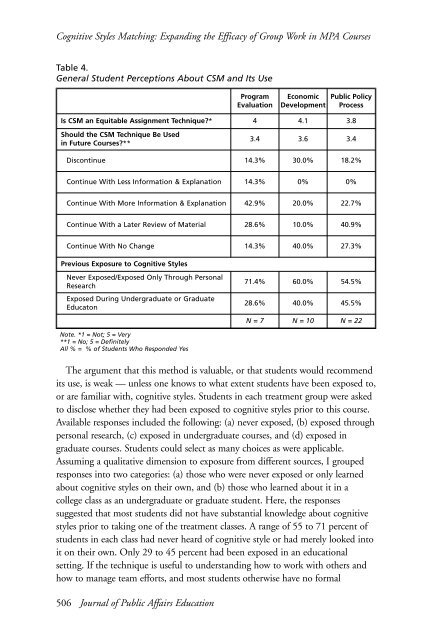JOURNAL OF PUBLIC AFFAIRS EDUCATION - National ...
JOURNAL OF PUBLIC AFFAIRS EDUCATION - National ...
JOURNAL OF PUBLIC AFFAIRS EDUCATION - National ...
You also want an ePaper? Increase the reach of your titles
YUMPU automatically turns print PDFs into web optimized ePapers that Google loves.
Cognitive Styles Matching: Expanding the Efficacy of Group Work in MPA Courses<br />
Table 4.<br />
General Student Perceptions About CSM and Its Use<br />
The argument that this method is valuable, or that students would recommend<br />
its use, is weak — unless one knows to what extent students have been exposed to,<br />
or are familiar with, cognitive styles. Students in each treatment group were asked<br />
to disclose whether they had been exposed to cognitive styles prior to this course.<br />
Available responses included the following: (a) never exposed, (b) exposed through<br />
personal research, (c) exposed in undergraduate courses, and (d) exposed in<br />
graduate courses. Students could select as many choices as were applicable.<br />
Assuming a qualitative dimension to exposure from different sources, I grouped<br />
responses into two categories: (a) those who were never exposed or only learned<br />
about cognitive styles on their own, and (b) those who learned about it in a<br />
college class as an undergraduate or graduate student. Here, the responses<br />
suggested that most students did not have substantial knowledge about cognitive<br />
styles prior to taking one of the treatment classes. A range of 55 to 71 percent of<br />
students in each class had never heard of cognitive style or had merely looked into<br />
it on their own. Only 29 to 45 percent had been exposed in an educational<br />
setting. If the technique is useful to understanding how to work with others and<br />
how to manage team efforts, and most students otherwise have no formal<br />
506 Journal of Public Affairs Education<br />
Program<br />
Evaluation<br />
Economic<br />
Development<br />
Public Policy<br />
Process<br />
Is CSM an Equitable Assignment Technique?* 4 4.1 3.8<br />
Should the CSM Technique Be Used<br />
in Future Courses?**<br />
3.4 3.6 3.4<br />
Discontinue 14.3% 30.0% 18.2%<br />
Continue With Less Information & Explanation 14.3% 0% 0%<br />
Continue With More Information & Explanation 42.9% 20.0% 22.7%<br />
Continue With a Later Review of Material 28.6% 10.0% 40.9%<br />
Continue With No Change 14.3% 40.0% 27.3%<br />
Previous Exposure to Cognitive Styles<br />
Never Exposed/Exposed Only Through Personal<br />
Research<br />
Exposed During Undergraduate or Graduate<br />
Educaton<br />
Note. *1 = Not; 5 = Very<br />
**1 = No; 5 = Definitely<br />
All % = % of Students Who Responded Yes<br />
71.4% 60.0% 54.5%<br />
28.6% 40.0% 45.5%<br />
N = 7 N = 10 N = 22

















